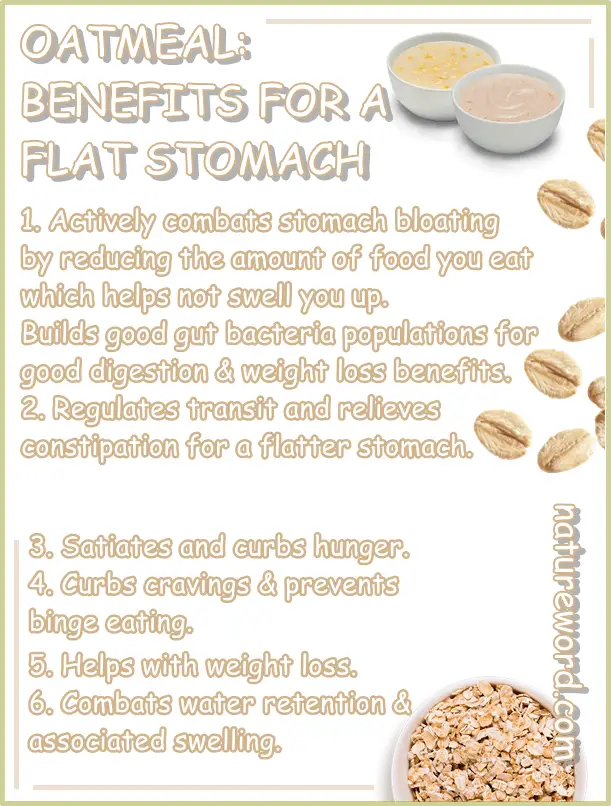Oatmeal, aka oats porridges, is probably one of the simplest and easiest breakfasts you can eat for a flat stomach. The traditional breakfast option is both healthy and cheap, all the while providing good nutrition and a range of wonderful benefits for health, including a flatter stomach.
Eating oatmeal combats bloating and regulates transit, curbs hunger and cravings and prevents binge eating, helping you get a flat stomach with minimal effort.
What is oatmeal?
Oatmeal, also known as oats porridge, is a type of porridge made with oats. It can be made with rolled oats, either thin-rolled or thick-rolled oats, and even oats flour. To make oats porridge, the oats are boiled in water, dairy milk or non-dairy milk. Toppings may be added to the porridge, and also sweeteners ranging from plain table sugar to more natural options such as raw honey or maple syrup.

How oatmeal helps you get a flat stomach
How does eating oatmeal in the morning help you get a flat stomach? There are a few ways:
1- Oatmeal combats bloating
One of the biggest obstacles that stand in the way of a flat stomach is bloating. If you don’t naturally carry most of your excess weight around your abdomen and are normal weight, but are still not even near a flat stomach, then it might be time to switch up your diet.
Diet is one of the main causes behind bloating and changing the types of foods you eat can combat and relieve bloating and help you get a flatter stomach.
Oatmeal is a great food for bloating. For one, you only actually need to eat very little of it – just 50 to 70 grams of rolled oats (depending on your size) and 200 to 250 milliliters of milk is enough for a satiating and satisfying meal to keep you nourished and energized from morning to lunch.
Reducing your actual intake of food per meal is a great way to prevent bloating to begin with – when you don’t eat very much at once, there just isn’t enough food to swell you up.
Oatmeal Pevent bloating
Oatmeal is also good for preventing bloating because it’s made up of just two ingredients, three if you choose to sweeten it, or four if you add a topping, but even the sweetener and toppings that go with the oats porridge are light. This is actually rare for a meal. Having meals as simple as possible, with as few ingredients as possible, is great for preventing bloating and keeping your stomach flat.
Long term, eating oatmeal helps build good gut flora populations. Rolled oats are a whole grain, full of dietary fiber with excellent prebiotic properties.
Dairy milk, if used, can add to the prebiotic benefits, especially if the milk is raw. Prebiotic foods feed gut flora and help grow existing populations for optimal bowel health, with systemic benefits.
Studies show having a balanced and varied gut flora helps the body better digest food and prevent bloating as a result – food sensitivities and intolerances commonly cause bloating which is a sign the body is experiencing difficulty in processing a food.
A balanced gut flora also translates into a more effective use of the energy obtained from food which can help prevent weight gain.
According to research, building a good gut flora system directly and meaningfully helps with weight control and weight loss as specific types of gut bacteria and other gut microorganisms are more favorable towards a lower body weight and, by extension, a flatter stomach.

2- Oatmeal regulates transit and relieves constipation
Having oatmeal in the morning for breakfast every day or every other day is a great way to regulate transit and increase the frequency of bowel movements. Having regular, ideally daily, bowel movements can help you get a visibly flatter stomach within days (provided you also don’t overeat and eat reasonably clean during the rest of your meals).
This is because a healthy, generous intake of dietary fiber purges you and keeps you satiated even with small amounts of food – this combats bloating and contributes to a visibly flatter stomach.
The prebiotic benefits of oatmeal further help recover beneficial intestinal flora populations which helps with weight control and weight loss – this holds important benefits for bloating and can help you have a flatter stomach.
3- Oatmeal satiates and curbs hunger
Oatmeal is a filling meal that helps keep you satiated and fueled with energy for hours, curbing hunger. Eating just plain oatmeal in the morning for breakfast is enough to keep you going until lunch.
Oats are a whole grain and rich in complex carbohydrates and indigestible dietary fiber which slow down digestion, causing energy from food to be released gradually over the course of many hours. This curbs hunger and prevents overeating, helping with weight control for a flatter stomach.
How much fiber in oats?
A serving of 50 grams of rolled oats gets you 5 grams of dietary fiber. A serving of 70 grams of rolled oats gets you 7 grams of dietary fiber. The average adult should eat 28 grams of dietary fiber per day.
A serving of 70 grams of oats is the equivalent of 25% of the total recommended intake of fiber for an entire day for the average adult, while a serving of 50 grams accounts of close to 18% of total fiber requirements.
4- Oatmeal curbs cravings
Balancing your macronutrients is a great way to curb both hunger and cravings, and prevent binge eating leading to weight gain and excess stomach weight.
Oatmeal can constitute a balanced meal providing all three essential macronutrients if it’s made with dairy milk or has certain toppings such as raw almonds, cashews, walnuts or other nuts and seeds.
The oats themselves account for the carbohydrate portion of the meal, providing a good content of primarily complex carbohydrates to satiate and curb hunger and cravings.
Dairy milk, ideally 2% fat and higher, provides sufficient fat to boost satiation and mental satisfaction. Both the oats and the dairy milk provide limited amounts of protein to complete the macronutrient balance and stop cravings.
Eating meals that are balanced in macronutrients – carbs, fat, protein – helps you feel satiated and mentally satisfied with your meal, preventing cravings and associated binge eating.
No cravings means better control over what you eat and paves the way to achieving and maintaining a healthy weight and a flat stomach.
5- Oatmeal prevents overeating and helps with weight loss
A meal such as oatmeal can constitute an effective tool for weight loss. For one, oatmeal is a diet meal – it’s low in calories and low in fat. Oatmeal made with 50 grams of oats and 200 ml of low fat 1.5% milk has only 280 kilocalories (calories).
Adding 10 grams of brown sugar and 10 grams of raw nuts or seeds such as almonds or sesame seeds boosts the energetic value of the meal to 380 kilocalories which still counts as a diet meal.
Not just this, but oatmeal made with dairy milk and topped with raw nuts or seeds is balanced in macronutrients which helps curb cravings and prevent binge eating. Such a meal is ideal for weight management and helps achieve sustainable weight loss without compromising nutritional value, paving the way to a lower body weight and a flatter stomach.
6- Oatmeal combats water retention and swelling
Eating too much sodium makes the body retain excess amounts of fluid and this creates swelling in the arms, legs, hand and feet, but also face and stomach. A lot of times, correcting water retention visibly improves the appearance of the stomach, making it look flatter.
Eating oatmeal actively combats water retention and associated swelling, including swelling of the abdomen. A serving of oatmeal made with just 50 grams of rolled oats and 200 milliliters of low fat 1.5% or 1% cow milk can get you close to 40% of total daily magnesium values and 11% of daily potassium values.
See what is the potassium content in milk of different types.
Magnesium and potassium are electrolytes that regulate body fluids and counteract the side effects of excess sodium. Getting enough of the two in the diet can meaningfully reduce swelling, including abdominal swelling and help you achieve a flatter looking stomach.
For benefits for water retention and associated swelling, choose dairy milk and go for low-fat options which both have fewer calories and help you lose weight and provide extra minerals to actively combat swelling due to water retention.
Low fat and non-fat dairy milk both have part of their fat content removed and replaced by the liquid portion of milk which comes with extra potassium and magnesium which actively combat fluid retention and associated swelling.
